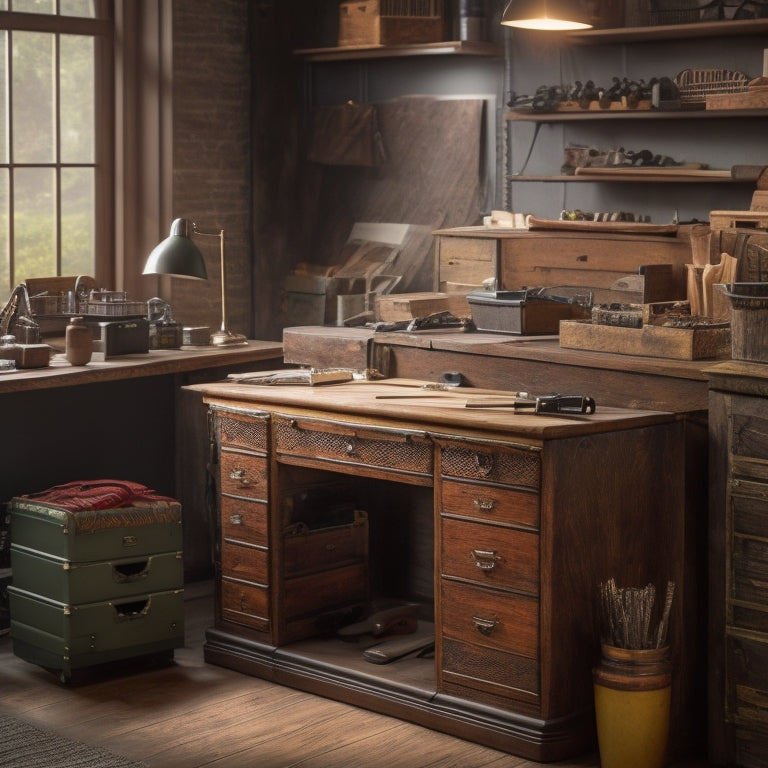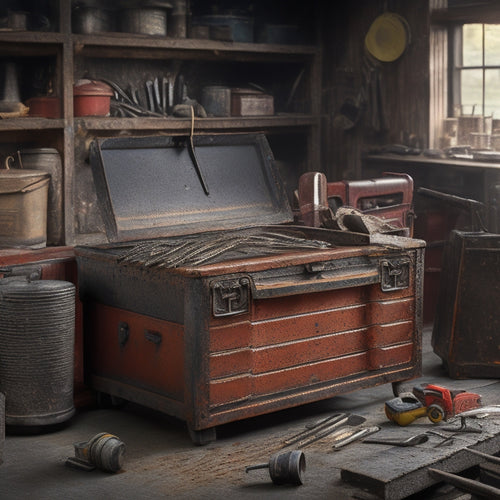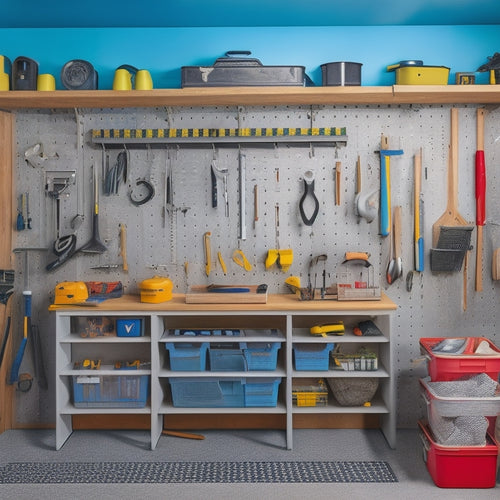
Small Tool Chests With Drawers for Compact Workspaces
Share
When selecting a small tool chest with drawers for your compact workspace, consider the benefits of maximizing available room, reducing clutter, and enhancing productivity. You'll want to assess your workspace needs, identifying obstacles, inefficiencies, and accessibility requirements. Look for a tool chest with customizable storage, adjustable dividers, and a compact design that maximizes vertical space. Top brands like DeWalt, Milwaukee, and Stanley offer a range of options with varying warranties and features like electronic locks and soft-close mechanisms. By choosing the right tool chest, you'll be able to optimize your workspace and elevate efficiency - and with the right guidance, you'll be able to access even more storage potential.
Key Takeaways
- Compact tool chests with drawers maximize available room in cramped environments, reducing clutter and increasing productivity.
- Drawer configurations, customizable storage, and materials like metal and plastic offer durability benefits for tool organization.
- Measuring and assessing workspace needs helps determine the ideal tool chest size, weight capacity, and security features.
- Categorizing tools by frequency of use, size, and type enables efficient organization and accessibility within the tool chest.
- Features like soft-close mechanisms, compact drawers, and security options ensure a functional and secure tool storage solution for compact workspaces.
Benefits of Compact Tool Storage
Optimizing your workspace with compact tool storage solutions yields numerous benefits, particularly in cramped environments where every square inch counts.
By incorporating space-efficient storage systems, you can maximize your available room, reducing clutter and increasing productivity. Compact tool storage solutions enable you to organize your tools and equipment in a logical and accessible manner, making it easier to find what you need when you need it.
This, in turn, saves you time and reduces the risk of accidents caused by misplaced or disorganized tools. Effective organization methods also help prevent tool damage and loss, which can be costly to replace.
Additionally, compact tool storage solutions promote a cleaner and more organized workspace, reducing the risk of tripping hazards and other safety concerns.
Types of Small Tool Chests
What options do you have when it comes to small tool chests? You'll find a range of designs and features to suit your specific needs.
Portable tool chests, for instance, are ideal for those who need to move their tools frequently. These compact chests typically have a handle or wheels, making them easy to transport around the workspace or to different job sites.
When considering drawer configurations, you'll find various options. Some small tool chests have a single, large drawer, while others have multiple smaller drawers or a combination of both.
The number and size of drawers will depend on the type and quantity of tools you need to store. Look for chests with adjustable dividers or inserts to customize the storage space and keep your tools organized.
Other considerations include the material and construction of the chest. Metal and plastic are common materials, each offering its own benefits regarding durability and weight.
Consider the overall size, weight capacity, and security features, such as locks or latches, to guarantee your tools are safe and secure.
Measuring Your Workspace Needs
You'll need to assess your current storage space to determine what's working and what's not, then identify the essential tools you need to keep within easy reach.
Next, measure the available dimensions of your workspace to understand the maximum size of the tool chest you can accommodate.
Assess Current Storage Space
Your workspace's spatial constraints dictate the size and style of tool chest you can accommodate. To optimize storage and guarantee a safe working environment, it's crucial to assess your current storage space. This involves evaluating the available space, identifying areas of inefficiency, and determining the best layout for your tools and equipment.
-
Measure the length, width, and height of your workspace to determine the maximum size of the tool chest that can fit comfortably.
-
Identify any obstacles or limitations, such as pipes, electrical outlets, or narrow walkways, that may impact the placement of your tool chest.
-
Consider the frequency of use and accessibility needs for your tools and equipment to guarantee that your tool chest is designed for efficient storage and retrieval.
Identify Essential Tools Needed
Five essential categories of tools typically dominate a compact workspace: fastening, cutting, measuring, material handling, and testing. You'll need to identify the specific tools within these categories that are vital for your work. Start by making a list of essential hand tools, such as pliers, screwdrivers, and wrenches. These will form the backbone of your toolset.
Next, consider the must-have power tools that will help you complete tasks efficiently. A cordless drill, impact driver, and circular saw are often indispensable in compact workspaces.
Don't forget to include measuring tools like tapes, levels, and calipers to guarantee accuracy in your work.
When selecting tools, prioritize those that serve multiple purposes or can be used in a variety of applications. This will help minimize clutter and optimize your workspace.
Additionally, consider the safety features of each tool, such as ergonomic design, protective guards, and secure storage options. By focusing on these essential tools, you'll be well-equipped to tackle a range of tasks while maintaining a safe and organized workspace.
Determine Available Dimensions
With your toolset taking shape, it's time to shift focus to the physical space where you'll be working. You need to determine the available dimensions to guarantee your small tool chest fits comfortably and leaves enough room for movement. Measure the length, width, and height of your workspace to identify any obstacles or constraints.
- Take note of any windows, doors, or corners that may affect the placement of your tool chest.
- Consider the distance between your workbench and any surrounding walls or equipment.
- Measure the clearance beneath any shelves or overhead storage to guarantee your tool chest fits underneath.
When selecting a small tool chest, consider the drawer materials and configurations that will best suit your needs. For example, a chest with soft-close drawers and durable materials can help prevent accidents and prolong the life of your tools.
Top Brands for Small Tool Chests
Choosing the right brand for your small tool chest can be an intimidating task, especially when faced with the numerous options available in the market. You want a brand that offers quality, reliability, and durability, ensuring your tools are safe and organized. When it comes to small tool chests, you can't go wrong with top brands like DeWalt, Milwaukee, and Stanley.
These brands have built a reputation for manufacturing high-quality products that cater to the needs of professionals and DIYers alike. They offer a range of small tool chest options, each designed to provide excellent storage and organization for your tools.
Here is a brief comparison of these top brands:
| Brand | Product Range | Warranty |
|---|---|---|
| DeWalt | 10-20 tool chests | 3-5 years |
| Milwaukee | 15-30 tool chests | 5-7 years |
| Stanley | 5-15 tool chests | 2-3 years |
When making your decision, consider factors like product range, warranty, and customer reviews. By choosing a top brand, you can be confident that your small tool chest will meet your needs and provide years of reliable service.
Features to Consider in Drawers
When selecting a small tool chest for your compact workspace, you'll want to take into account the drawer size options to guarantee they accommodate your tools and accessories.
You'll also appreciate soft-close mechanisms that prevent drawers from slamming shut, reducing noise and wear on the chest.
Drawer Size Options
You'll find that small tool chests often feature drawers in various sizes to accommodate diverse tool sets and workspace constraints. This versatility is vital in compact workspaces where every inch counts.
When selecting a small tool chest, consider the drawer size options that best fit your needs.
-
Compact drawers: Ideal for storing small tools and accessories, such as screwdrivers, pliers, and wrenches.
-
Medium-sized drawers: Suitable for housing larger tools, like drills, saws, and sanders, while still allowing for easy access.
-
Deep drawers: Perfect for storing bulky items, like power tools, equipment, and materials, keeping them organized and out of the way.
Drawer configurations and materials also play a significant role in determining the overall functionality of the tool chest.
Look for drawers made from durable materials, such as steel or aluminum, that can withstand the rigors of frequent use.
Additionally, consider the drawer's internal organization features, like dividers and inserts, to guarantee efficient storage and retrieval of your tools.
Soft-Close Mechanisms
As you configure your ideal small tool chest, the drawer's internal mechanisms become just as important as its size and material. Soft-close mechanisms are an essential feature to take into account, as they guarantee a smooth and controlled closure of the drawers, preventing sudden slams that can cause injuries or damage to the tools.
Soft-close mechanisms offer several benefits, including:
| Benefit | Description | Importance |
|---|---|---|
| Reduced Noise | Soft-close mechanisms minimize the noise level when closing the drawers, creating a more peaceful work environment. | High |
| Increased Safety | They prevent sudden slams, reducing the risk of injuries and accidents. | High |
| Tool Protection | Soft-close mechanisms help protect your tools from damage caused by sudden impacts. | Medium |
| Durability | They reduce the wear and tear on the drawer slides, increasing the overall lifespan of the tool chest. | Medium |
| Convenience | Soft-close mechanisms provide a smooth and effortless closing experience, making it easier to access your tools. | Low |
When selecting a small tool chest, look for soft-close mechanisms that are built to last and can withstand heavy use. Reflect on the benefits they offer and how they can enhance your overall working experience.
Security Options for Tool Chests
Securing your tool chest is essential to preventing theft and unauthorized access to your prized tools and equipment.
You've invested time and money into accumulating your tools, and losing them can be devastating. To protect your investment, consider the following security options:
-
Electronic Locks: These locks use a digital combination or keycard to grant access to your tool chest. They're convenient and can be programmed to allow multiple users.
-
Disc Tumbler Locks: These locks use a rotating disc to prevent picking and are highly resistant to forced entry.
-
Hasp and Staple Locks: These locks allow you to add a padlock to your tool chest, providing an additional layer of security.
When choosing a lock option, consider the level of security you need, the ease of use, and the durability of the lock.
Don't compromise on the security of your tool chest - invest in a reliable lock option that will give you peace of mind.
Organizing Small Tool Chests Efficiently
One of the biggest challenges of working with small tool chests is efficiently organizing the limited space to maximize tool accessibility. You'll want to make certain that every tool is easily reachable and visible to prevent accidents and wasted time. Start by categorizing your tools into groups based on their frequency of use, size, and type. This will help you determine the most effective layout for your tool chest.
Next, focus on drawer organization. Assign specific drawers to specific tool categories, and use dividers or inserts to separate tools within each drawer. This will prevent tools from getting jumbled and make it easier to find what you need quickly.
Consider using a pegboard or hooks on the back of the chest or on a wall to hang frequently used tools, freeing up space in the drawers.
When organizing your tool chest, prioritize tool accessibility. Place your most frequently used tools in easy-to-reach locations, such as the top drawer or near the front of the chest.
Best Uses for Compact Tool Chests
With your compact tool chest efficiently organized, you're now ready to access its full potential.
Compact tool organization is all about maximizing storage capacity while maintaining easy access to your tools. By doing so, you'll save time and reduce frustration when working on projects.
Some of the best uses for compact tool chests include:
-
Mobile tool storage: Take your compact tool chest to the job site or move it around your workshop to keep your tools close at hand.
-
Workbench organization: Use your compact tool chest as a supplement to your workbench, storing frequently used tools and keeping your workspace clutter-free.
-
Specialized tool storage: Designate your compact tool chest for a specific trade or task, such as electrical, plumbing, or automotive work, to keep related tools and accessories organized and within reach.
Space-Saving Design Ideas
By incorporating space-saving design ideas into your compact tool chest, you can further optimize its storage capacity and efficiency. A minimalist design approach helps eliminate unnecessary features, allowing you to focus on essential tools and equipment. This streamlined approach enables you to make the most of the available space, reducing clutter and improving overall organization.
One effective space-saving strategy is to employ vertical storage. This involves installing drawers, shelves, or compartments that maximize the chest's vertical space. By storing less frequently used items towards the top and more frequently used items at eye level, you can reduce bending and stretching, promoting a safer working environment.
Additionally, consider using adjustable dividers or inserts to customize your storage compartments, ensuring a snug fit for each tool and preventing damage or misplacement. By implementing these space-saving design ideas, you can create a compact tool chest that's both functional and efficient, perfect for compact workspaces.
Frequently Asked Questions
Can Small Tool Chests Be Mounted on Wheels for Mobility?
You can enhance the mobility of your tool chest by exploring wheel attachment options, ensuring a stable and secure fit to prevent accidents, and selecting the right wheel type for your specific needs, such as soft wheels for hardwood floors.
Are Tool Chests With Drawers Suitable for Outdoor Use?
Imagine a rugged adventurer lugging a treasure chest through a torrential downpour; you'll want your tool chest to be just as resilient. Look for weather-resistant materials and outdoor durability features, like rust-proof locks and UV-stable coatings, to guarantee your tools stay protected.
Can I Customize Small Tool Chests to Fit My Specific Needs?
You can customize tool chests to fit your specific needs by optimizing drawer organization and tool accessibility, ensuring frequently used tools are easily reachable, and implementing dividers or inserts to prevent clutter and enhance safety.
Are Compact Tool Chests Suitable for Heavy-Duty Tool Storage?
Can you really trust compact tool chests with your heavy-hitters? Yes, you can! Look for models built with heavy-duty materials that boast ample storage capacity, ensuring your prized tools remain organized, protected, and within reach.
Can I Lock Individual Drawers on a Small Tool Chest?
You can enhance drawer security by opting for small tool chests with individual locking mechanisms, allowing you to restrict access to specific drawers, protect precious tools, and prevent unauthorized use or theft.
Conclusion
As you optimize your compact workspace, a small tool chest with drawers becomes the unsung hero, corralling chaos into precision. With every wrench and screwdriver in its assigned slot, your workflow hums like a fine-tuned engine. By investing in the perfect miniature marvel, you'll access a domain of productivity, where every minute counts and every inch matters.
Related Posts
-

Maximum Capacity Tool Boxes for Heavy-Duty Use
You need a maximum capacity tool box that can withstand the rigors of heavy-duty use, protecting your essential tools...
-

Advantages of a Pegboard System in Your Garage
You can instantly alter your garage into a more organized, efficient, and productive space by installing a pegboard s...
-

Custom Pegboard Storage for Your Workshop
You're looking to create a custom pegboard storage system that maximizes your workshop's space, enhances productivity...


